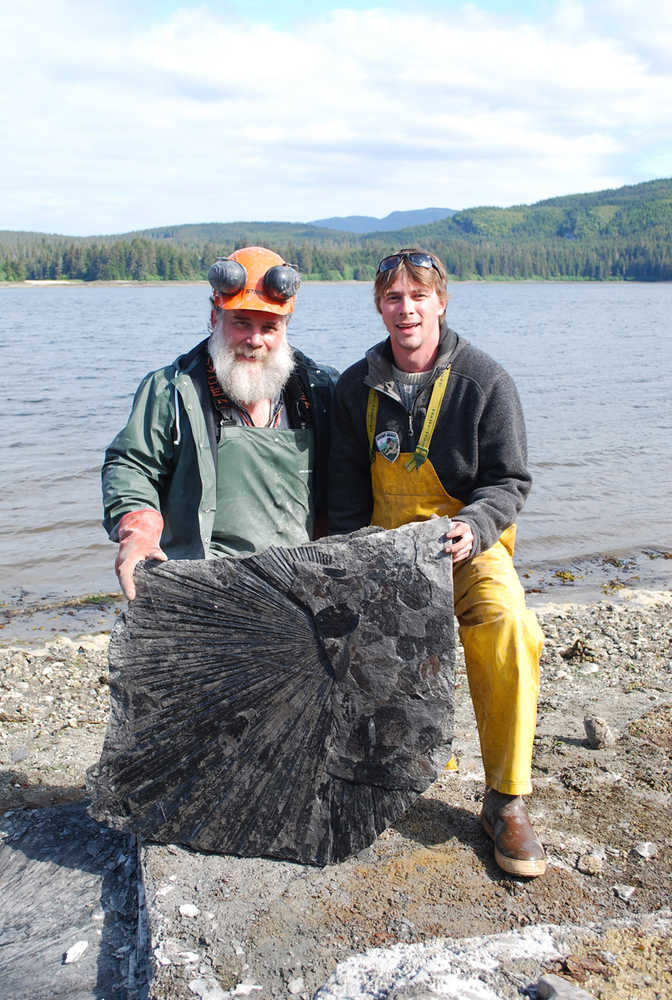Once upon a 50- to 57-million-year distant time, just after dinosaurs went extinct, Southeast Alaska was a much warmer place. Palm trees grew in the lands around Kake. An ancient ancestor of the modern horse squished its three-toed footprints into marshy ground. A metasequoia frond — an ancestor of the modern-day redwood — drifted its way down to the land, a flightless terror bird either scavenged or hunted, depending on your theory, and a hippo-like semi-aquatic mammal browsed for food.
A team of scientists has found fossils on Kupreanof Island that show signs of the plants and animals of between 50 and 57 million years ago, many while being filmed for PBS’ “Making North America,” a three-part series set to air in early November.
U.S. Forest Service geologist Jim Baichtal, geoarchaelogist Ian Putnam, Kirk Johnson, paleobotanist and Director of the Smithsonian Museum of Natural History, and Ketchikan artist Ray Troll, along with a film crew, went to Kupreanof Island in early summer of 2014 looking for fossils.
Scientists have known that Alaska was once a much warmer place for quite a while (crocodiles once swam the Arctic) but that knowledge seems to be filtering down to the general public more recently, Putnam said.
“In this case, the climate was so warm that there were palm trees in very far north latitudes,” Putnam said. “Climate can change … What’s interesting is the latitude of the continents at that point in time. The location of Southeast Alaska is pretty much the same as it is now.”
Baichtal had explored these areas before, but hadn’t yet found a full palm leaf, he said. People have been documenting those kinds of finds for a long time, Baichtal pointed out; a 1936 U.S. Geological Survey study mentions fossils in the area. Many studies that mention them didn’t collect fossils, however; they just noted their presence.
The Eocene period, when these fossils were created, is “probably one of the warmest periods of the Earth’s climate,” Baichtal said.
The earth was around 14 degrees Celsius (around 25 degrees Fahrenheit) higher than average 1960s temperatures, he said.
From earlier publications, they knew about a particular deposit of the right age near Kake, Baichtal said. Several years ago, he and Johnson had found palm fragments, cycads (a kind of plant) and “incredible” leaf deposits, and were pretty sure if they kept looking, they could find a whole palm frond fossil.
For the filming, the team took advantage of some extreme low tides to start pulling up slabs of shale in that deposit.
“I found this layer that looked really promising, and had driven my chisels in there,” Baichtal said. “Kirk said ‘Would you come over here and help us turn over this slab?’ That was the slab that had the little eohippus (prints from an ancestor of the horse). I got back down to pull out my chisels, and I thought ‘I already got this far, I might as well pull up.’”
When he did, he found a significant chunk of a palm fossil. They got two chunks that day, and went back the next for the third.
The palm leaf fossil, which is 6.5 feet across, is now at the University of Alaska, Fairbanks’ Museum of the North, on display. Based on the sediments, U.S. Geological Survey research geologist Susan Karl estimates it’s between 51 and 54 million years old, Baichtal said.
This year, Baichtal, UAF’s Museum of the North’s earth science curator Patrick Druckenmiller, and operations manager Kevin May went back to Kupreanof and found more palm fronds, the base of the fronds — which they hadn’t yet found — “many slabs containing thousands of leaves,” petrified logs, and large mammal tracks like the pantodont (a four-legged, browsing mammal of varying size; this one may have been the coryphodon, a semi-aquatic hippo-like animal) and, possibly, a giant tridactyl bird and a few other smaller birds, Baichtal said. Those casts he estimates are between 50 and 57 million years old.
While Kupreanof Island is proving to have significant fossil deposits, Alaska has other rich deposits as well: scientists have found dinosaur skeletons, palm fronds, and other ancient fossils not only near Kake, but also near the Malaspina Glacier near Yakutat, the Matanuska coal fields, and other places. Many of those finds are now at the Museum of the North. Regardless, scientists say the fossils found in Southeast are incredible specimens, evocative of a long-distant time in a place now very different.
“(Animals) were walking in these wet marshlands, making imprints. The imprints filled with sand, and now we have a cast of those footprints,” Baichtal said. “It paints a really kind of a neat picture of the transition when basically the dinosaurs were gone, the mammals were rising, and the Earth was incredibly warm … (Southeast Alaska) would have been a hot place to go sit on the beach and have little drinks … It’s little known stuff. It’s a cool part of the geology of Southeast Alaska.”
Watch a preview of the show here: http://www.pbs.org/wgbh/nova/earth/making-north-america.html. You can see previews of Alaska beginning soon after the 3-minute mark.
The program is scheduled to air Nov. 4, 11 and 18 on PBS.
• Contact Juneau Empire outdoors writer Mary Catharine Martin at maryc.martin@juneauempire.com.

